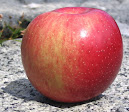"Glocken" means bell, which describes the characteristic shape of this elongated and tapered apple.

|
My two Glockenapfels are medium-to-large, ribbed, tapered, and elongated. The photographed sample if anything understates this, but it has the better color (yellow) and blush. They are quite firm in hand.
The lenticels are tiny, light in the blush and barely visible elsewhere, unless filled in with a bit of dark grey.

The other sample is taller and greener with a much smaller and fainter blush. It also has just a bit of russet near the stem.
On inspection, the green of number 2 is organized into lighter and darker stripes, a bit like the peel of an Ananas Reinette.
My assumption is that Glocken number two is less ripe. We'll see which is better for eating.
Eating
The flavors are clearer in the riper (photographed) apple: cherries, berries (blackberries or raspberries) and spice.
Both are satisfyingly crisp and crunchy.

|
| This wikimedia image does a good job of showing Glockenapfel's elongated bell shape (photo: Sven Teschke CC BY-SA 3.0 DE). |
Although I am enjoying Glockenapfel for eating out of hand, the acidity is a lot to take and I think might just be too much for modern tastes.
Other than that, it is a great flavor set, if you get one that is fully ripe. And I wonder about the Glockenapfel's qualities for cooking and cider.
Update: Glock keeps pretty well.
Origins
Trees of Antiquity calls it "the traditional variety used for strudel," and Wikipedia says it is widely grown in Germany (while noting it may have originated in Switzerland).

What great timing! We're in Germany and looking to add a few trees to our orchard. We bought a case of Glockenapfel a few weeks ago and basically did the same thing that you did (ate some fresh and then waited a few weeks to see how they aged). Completely agree on the acidity. We used them for baking too, and they worked well. Also provided some good chunks in an applesauce made from several varieties. They are known for holding their shape when cooked. I'm not sure we'll plant one though. We already have a Belle de Boskoop and a Reine de Reinettes (aka Goldparmäne) for cooking. We were looking for something that would be good for fresh eating and to add another note to the flavor profile of our cider. I'm not sure this one is it.
ReplyDeleteWell you have, potentially, a bigger dataset than I do, at least for tracking Glocken over time! It does seem to be primarily a culinary apple in the mould of Boskoop and Calville Blanche.
DeleteGloster 69 (= Glockenapfel x Red Delicious) is somewhat more common today.
DeleteHaven't tasted the Glockenapfel, but Gloster seems to be more balanced to the dessert side.
P.S.
DeleteAnonymous wrote:
> We already have a Belle de Boskoop and a Reine de Reinettes (aka Goldparmäne) for cooking.
I don't remember if I've ever tasted it, so I wonder whether Reine des Reinettes / Goldparmäne / King of the Pippins is really that acidic, or it's just modern tastes? :-)
These things are inevitably mediated by taste. I think my readers understand, for instance, that what I call well balanced is going to be a good bit less sweet than a Honeycrisp.
DeleteI suppose it would be possible to cook up some scientific metric of PH vs Brix, but that is beyond me and in any case I'm mostly about qualitative description and assessment.